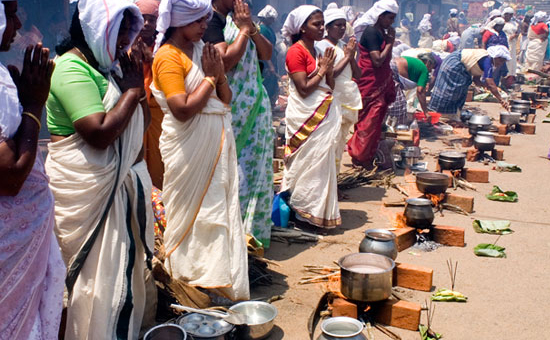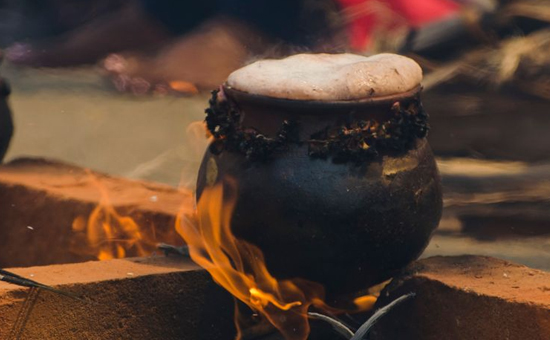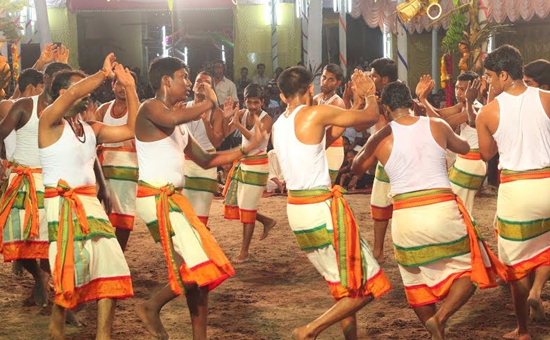-
This article tells you about Kerala’s all women festival, the reason for and nature of its celebration and the ten day Attukal festival.
The year 2019 is just a few weeks away. A major event in Kerala’s capital city of Thiruvananthapuram is the Attukal Pongala, the festival that entered the Guinness Book of World Record in 2009 for the largest number of women who converge at the Temple to personally prepare offerings for the Atukkal Amma, the Mother Goddess.
What makes this form of
offering Pongala special?
Come 20th February 2019 all
roads lead to the Temple and a large number of women descend on the city to
make their ritual offering to the Devi. This is the ninth day of the ten-day
festival when the eastern part of the city and a little over five kilometer
radius turns into millions of makeshift brick hearths fired by coconut fronds.
These are lit by an initial flame from the Temple to facilitate cooking of a payasam as an offering to the Goddess.
This ‘women only’ festival follows a unique method of making offering to the Goddess. It essentially is a one which propitiates the Devi to calm her down.
The origins of the Temple are pegged to the Kannagi episode in
the Silapathikaram, a famous work
composed by Elenkovadikal in the Sangam era.
The story goes that Kannagi married Kovilan, the son of a rich merchant. After their marriage, Kovilan fell in love with a dancer Madhavi. He spent all his wealth on her. When he lost everything he returned to Kannagi who had a pair of anklets. Kannagi told Kovilan to sell one anklet. Kovilan went to the market to sell this anklet. At that time the kingdom of Madurai was ruled by a Pandyan king whose soldiers mistook the anklet with Kovilan as that of their Queen’s, which had gone missing. The angry king ordered that Kovilan be killed.
When Kannagi heard the news, she rushed to the Palace and
showed the other anklet in her possession. The queen's anklet was made of pearls but Kannagi's
was made of ruby. The king and queen ended
their lives realizing the injustice meted out to Kovilan and and Kannagi. Thus
Kannagi cursed that the entire Madurai kingdom would be burnt down. Her curse led
to the destruction of Madurai. She is then supposed to have come to Kerala
through Kanyakumari. Enroute to Kodungallur, (a place in Kerala with a very aggressive
Devi installed there) she came to Attukal and rested there. Ladies there gave a warm welcome to Kannagi by
preparing pongal (the rice preparation). Later a temple was built in the place
where Kannagi took rest. This is one story behind origin of Attukal Temple.
The other version on the origins of the Temple is associated with local lore and geography. The Goddess is said to have appeared as a little girl before the head of the Mullaveetil family, on the banks of the Killi River asking to be helped to cross the river. Awestruck by the overall radiance and demeanor of the girl, the elderly person not only carried her across the river but also took her home. While the household got busy making arrangements to welcome her, the girl vanished, only to turn up one night in the man’s dream with the demand that she had marked with three lines a space in the sacred grove nearby, and wanted an abode put up on the spot for her. And so was built the Attukal Temple where the Devi was consecrated.
 Pongala raw materials for eg fronds, husk.
Pongala raw materials for eg fronds, husk.
A unique offering
The open hearth is made of three freshly
baked kiln bricks, usually three or four placed in a manner such that it can
hold an earthen pot which will be used to make the payasam. The lit fronds fire
the hearth and cooking starts at an auspicious time when the temple fire is lit
by the priest. To an ululation that rises from the women, spreading across the
kilometers they are seated the cooking starts.
The basic ingredients for this
preparation are rice, jaggery, grated coconut, cashew and kismis. The payasam
would be ready in an hour or thereabouts. Then, begins the wait for the priest
to shower purificatory water on the food prepared. With the numbers spilling
over to points far away from the Temple, and therefore impossible for human to
cover each hearth, a helicopter flies overhead and sprays holy water from
mid-air. The devotee is satisfied that the offering to the Devi is done,
usually by 3 pm or thereabout.
 Women praying post blessings from priest & after cooking Payasam
Women praying post blessings from priest & after cooking Payasam
It is a sight to behold: the city is
once again a sea of humanity when the women make their way back to their homes
on foot, train or four-wheelers, carrying with them the payasam blessed by
their Devi, Attukal Amma.
 A
typical Hearth
A
typical Hearth
A ten-day Attukal Festival
The ten-day festival begins with the ‘Kappukettu’ ritual. Kappu in Malayalam is heavy anklet. Here the Devi is adorned with anklets on this occasion (recall the anklet that Kovilan carried). Beginning from the first day the ‘thottampaatu’ which is the recital in verse form of the story of ‘Kannagi’ who, according to legends and a version of the origin of the Temple, is worshipped here.
The recital is the
hereditary right-duty of a chosen family over generations, and done from a palm
frond shed set up for the purpose in front of the Temple during Festival times,
and continues for all the ten days.
On the 9th
day when they sing about the destruction of the kingdom of Madurai by Kannagi in
her fury, the Pongala by the devotees is prepared to propitiate the Goddess who
is at the peak, wreaking her wrath. When
they sing the part on the destruction of the Madurai kingdom on the 9th day,
the women light fire to prepare the pongal.
Among the many
practices associated with the worship during the festival is ‘Kuthyottam’ performed by boys below 12 years of age. The belief is that these boys are the injured soldiers of Mahishasuramardhini. From the third day of festival the rigor of penance is observed by the boys who will undergo this exercise often made as a vow by parents. It includes, continuous stay in the temple for seven days, food restrictions which mean they take what is given at the Temple.
 Kuthyottam performed during festival.
Kuthyottam performed during festival.
The Goddess is taken out of the Temple
in a colorful procession to see her devotees and visit her brother the Dharmasastha
(Dharmashasta temple in nearby Manacaud). These Kuthyottom boys dressed up as
soldiers, also come along with Goddess. Next day they return back to the
temple. The Pongala festival concludes with Guruthi
puja which is a special ritual performed by the main priest.
 Lady devotees outside Attukul Temple
Lady devotees outside Attukul Temple
Architecture of Attukal Temple carries a strong influence of Tamil architecture with
traces of Kerala temple design. The gopuram or the temple tower at the entrance
has stories associated with Kannagi sculpted on it. The southern gopuram has
incidents from the Puranas the Dakshayaga carved on its face among other
elements from mythology. Overall the structure is more colorful than the traditional
temples of Kerala.
Also read by author All
you wanted to know worship of Swami Aiyappan